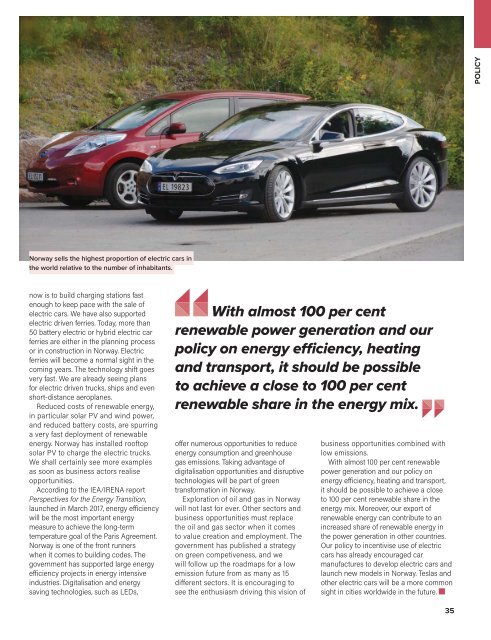Climate Action 2017-2018
Create successful ePaper yourself
Turn your PDF publications into a flip-book with our unique Google optimized e-Paper software.
POLICY<br />
Norway sells the highest proportion of electric cars in<br />
the world relative to the number of inhabitants.<br />
now is to build charging stations fast<br />
enough to keep pace with the sale of<br />
electric cars. We have also supported<br />
electric driven ferries. Today, more than<br />
50 battery electric or hybrid electric car<br />
ferries are either in the planning process<br />
or in construction in Norway. Electric<br />
ferries will become a normal sight in the<br />
coming years. The technology shift goes<br />
very fast. We are already seeing plans<br />
for electric driven trucks, ships and even<br />
short-distance aeroplanes.<br />
Reduced costs of renewable energy,<br />
in particular solar PV and wind power,<br />
and reduced battery costs, are spurring<br />
a very fast deployment of renewable<br />
energy. Norway has installed rooftop<br />
solar PV to charge the electric trucks.<br />
We shall certainly see more examples<br />
as soon as business actors realise<br />
opportunities.<br />
According to the IEA/IRENA report<br />
Perspectives for the Energy Transition,<br />
launched in March <strong>2017</strong>, energy efficiency<br />
will be the most important energy<br />
measure to achieve the long-term<br />
temperature goal of the Paris Agreement.<br />
Norway is one of the front runners<br />
when it comes to building codes. The<br />
government has supported large energy<br />
efficiency projects in energy intensive<br />
industries. Digitalisation and energy<br />
saving technologies, such as LEDs,<br />
With almost 100 per cent<br />
renewable power generation and our<br />
policy on energy efficiency, heating<br />
and transport, it should be possible<br />
to achieve a close to 100 per cent<br />
renewable share in the energy mix.<br />
offer numerous opportunities to reduce<br />
energy consumption and greenhouse<br />
gas emissions. Taking advantage of<br />
digitalisation opportunities and disruptive<br />
technologies will be part of green<br />
transformation in Norway.<br />
Exploration of oil and gas in Norway<br />
will not last for ever. Other sectors and<br />
business opportunities must replace<br />
the oil and gas sector when it comes<br />
to value creation and employment. The<br />
government has published a strategy<br />
on green competiveness, and we<br />
will follow up the roadmaps for a low<br />
emission future from as many as 15<br />
different sectors. It is encouraging to<br />
see the enthusiasm driving this vision of<br />
business opportunities combined with<br />
low emissions.<br />
With almost 100 per cent renewable<br />
power generation and our policy on<br />
energy efficiency, heating and transport,<br />
it should be possible to achieve a close<br />
to 100 per cent renewable share in the<br />
energy mix. Moreover, our export of<br />
renewable energy can contribute to an<br />
increased share of renewable energy in<br />
the power generation in other countries.<br />
Our policy to incentivise use of electric<br />
cars has already encouraged car<br />
manufactures to develop electric cars and<br />
launch new models in Norway. Teslas and<br />
other electric cars will be a more common<br />
sight in cities worldwide in the future.<br />
35












